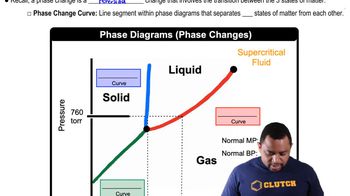Here are the essential concepts you must grasp in order to answer the question correctly.
Triple Point
The triple point of a substance is the unique set of conditions at which all three phases—solid, liquid, and gas—coexist in thermodynamic equilibrium. For water, this occurs at a specific temperature and pressure, which is precisely 0.01°C and 611.657 pascals. Understanding this concept is crucial for recognizing how temperature and pressure influence phase changes.
Recommended video:
Phase Equilibrium
Phase equilibrium refers to the state in which the different phases of a substance (solid, liquid, gas) exist simultaneously and their properties remain constant over time. In the context of the triple point, it means that the rates of phase transitions (melting, freezing, evaporation, condensation) are equal, allowing for stable coexistence of ice, water, and vapor.
Recommended video:
Phase Changes in Diagrams
Measurement Conditions
Accurate measurement of the triple point requires specific conditions, including a controlled environment where pressure and temperature are precisely maintained. In the case of water, achieving the triple point under 1 atm of air is not possible, as the pressure must be lower than atmospheric pressure to allow for the coexistence of all three phases. This highlights the importance of understanding how external conditions affect phase behavior.
Recommended video:
Units of Radiation Measurement




